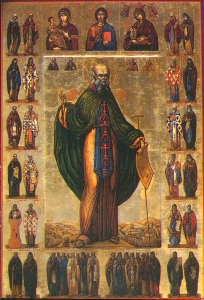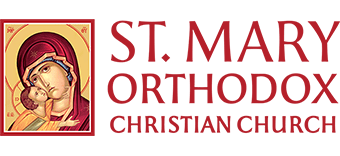St Saba the Sanctified (12-03-2023)
 December 5: Venerable Saba the Sanctified
December 5: Venerable Saba the Sanctified
(From The Prologue from Ochrid by St. Nicholai Velimirovich)
The unknown village of Mutalaska, in the province of Cappadocia, became famous through this great luminary of the Orthodox Church. St. Saba was born there of his parents John and Sophia. At the age of eight, he left the home of his parents and was tonsured a monk in a nearby monastic community of St. Flavian (Feb. 16). After ten years, he moved to the monasteries of Palestine and remained longest in the monastery of St. Euthymios the Great (Jan. 20) and St. Theoctistus (Sept. 3). The clairvoyant Euthymios prophesied of Saba that he would become a famous monk and a teacher of monks, and that he would establish a lavra (a cluster of monastic cells) greater than all the lavras of that time.
After the death of Euthymios, Saba withdrew to the desert, where he lived for five years as a hermit in a cave shown to him by an angel of God. Afterward, when he had matured in the monastic life, he began by divine providence to gather around him many who desired the spiritual life. Soon, such a large number gathered that Saba had to build a church and many cells. Some Armenians also came to him, and for them he provided a cave where they would be able to celebrate services in the Armenian language.
When Saba’s father died, his aged mother Sophia came to him, and he tonsured her a nun. He gave her a cell located at a distance from his monastery, where she lived a life of asceticism until her death.
This holy father endured many assaults from all sides: from those who were close to him, from heretics and from demons. But he triumphed over them all: those close to him, by kindness and indulgence; the heretics, by his unwavering confession of the Orthodox Faith; the demons, by the sign of the Cross and calling upon God for help. He had a particularly great struggle with demons on Mount Castellium, where he established his second monastery.
In all, Saba established seven monasteries. He and St. Theodosius the Great (Jan. 11), his neighbor, are considered to be the greatest lights and pillars of Orthodoxy in the East. They corrected emperors and patriarchs in matters of the Faith, and to everyone they served as an example of saintly humility and the miraculous power of God.
After a toilsome and very fruitful life, St. Saba entered into rest in 532 at the age of 94. Among his many wondrous and good works, let it at least be mentioned that he was the first to compile the Order of Services for use in monasteries, now known as the Jerusalem Typicon.
For Consideration
A man may be great in some skill, as a statesman or a military leader, but no one among men is greater than a man who is great in faith, hope, and love.
The greatness of St. Saba’s faith and hope in God is best shown by the following incident: One day, the steward of the monastery came to Saba and informed him that the following Saturday and Sunday he would be unable to the strike the semantron1, according to tradition, to the summon the brethren to the communal service and meal because there was not a trace of flour in the monastery nor anything at all to eat or drink. For this reason, even the Divine Liturgy was not possible. The saint replied without hesitation: “I shall not cancel the Divine Liturgy because of the lack of flour; faithful is He Who commanded us not to be concerned about bodily things, and mighty is He to feed us in time of hunger.” Saba placed all his hope in God. In this extremity, he was prepared to send some of the ecclesiastical vessels or vestments to be sold in the city so that the brothers would be deprived neither of the divine services nor the customary meal.
However, before Saturday, some men, moved by divine providence, brought thirty mules laden with wheat, wine and oil to the monastery. “What do you say now, brother?” Saba asked the steward. “Shall we not strike the semantron and assemble the fathers?” The steward was ashamed because of his lack of faith and begged the abbot for forgiveness.
Saba’s biographer describes this saint as “severe with demons but mild toward men.” Once, some monks rebelled against Saba, and for this they were driven from the monastery by order of Patriarch Elias. They built themselves huts by a river near Tekoa, where they endured privation in all things. Hearing that they were starving, Saba loaded mules with flour and brought it to them personally. Seeing that they had no church, he built one for them. At first, the monks received Saba with hatred, but later, they responded to his love with love and repented of their former misdeeds toward him.
May we have his intercession before God.
1 A long piece of wood, shaped for resonance and struck rapidly with a mallet.



